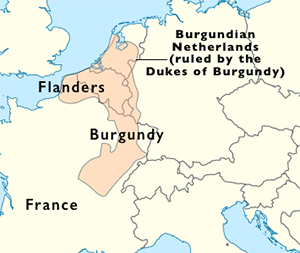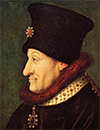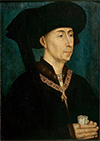The Burgundian Netherlands
The Burgundian Netherlands was a geographical and political entity that lasted for nearly a century in the Middle Ages. It comprised what is now Belgium, Luxembourg, the Netherlands, and northern France. 
The name comes from a combination of two entities, the former stemming from French royalty and the latter the familiar name for the Low Countries. The French connection was to a series of the Dukes of Burgundy, who came from France's House of Valois. It was Philip the Bold who was the first Duke of Burgundy to rule over the Burgundian Netherlands. His wife was Margaret III of Flanders, who had inherited the County of Flanders from her father, Count Louis II, who had died in 1384. Philip, by right of marriage to Margaret, also claimed that inheritance. Philip was also the son of France's King John II and so had various other responsibilities in that realm. Burgundy proper was in south central France, but Burgundian rulers had expanded their reach northward; by the time that Philip the Bold assumed the rule of Burgundy, its relative borders were very close indeed to the Low Countries. 
Philip the Bold (left) began something resembling a dynasty, ruling over the Burgundian Netherlands for 20 years before his death, in 1404, and then giving way to eventually three of his sons, John the Fearless (1404–1419), Philip the Good (1419–1467), and Charles the Bold (1467–1477). It was Philip the Bold who violently put down a revolt in Ghent, in 1385, and then seized overall power in France twice, both times in the wake of succession controversies. He made significant use of gunpowder artillery in his battles, as did his oldest son, John the Fearless, who sought to profit from the mental illness of France's King Charles VI and ended up starting a civil war, which ended with his own assassination, in 1419. 
Father and sons expanded the territorial borders through a combination of inheritance, purchase, and seizure. Added to the mix were the Counties of Hainaut, Holland, Namur, and Zeeland and the Duchies of Brabant, Guelders, and Limburg. Each had its own governmental structure and nominally reported to the Duke of Burgundy. The dukes began by establishing personal rule and then, after some instances of fierce resistance, gave way to the representative Estates General, which first met in 1464, under Philip the Good. That monarch also founded the Order of the Golden Fleece, an association of chivalry designed to echo earlier Crusader orders, King Arthur's Knights of the Round Table, and the Greek legend of Jason's pursuing a fleece of gold. French was the language of state and court, but Dutch was spoken more widely throughout the territories. Large centers of population and commerce included Antwerp, Bruges, Brussels, Ghent, and Mechelen. Thriving industries included brewing, metalwork, and textile production. Bruges and Brussels were also destinations for artists, including the famous painters Jan van Eyck and Rogier van der Weyden. Artists at this time also excelled at the longstanding practice of illuminating manuscripts. 
Philip the Good presided over the greatest successes of the Burgundian Netherlands. He it was who made van Eyck court painter and ordered the creation of many tapestries to hang at court. He it also who seized the inspirational French maid and war leader Joan of Arc, ransoming her to England during the waning years of the Hundred Years War. He found himself having to echo his father's revolt-suppression strategies in Liéege and Bruges and died during the latter, in 1467. Philip's younger brother Charles the Bold took over rule of the Burgundian Netherlands and set himself on a path of territorial acquisition, paying for one land and conquering a few more. He also crushed yet another revolt in Liége. His actions triggered a war with the Old Swiss Confederacy and the Duchy of Lorraine; the forces of those two entities joined against Charles and were victorious, eliminating him as a threat at Nancy. When Charles the Bold died, in 1477, territorial rule passed to his only child, Mary. That same year, she married Archduke Maximilian of Austria. He became co-ruler of the Burgundian Netherlands at that time and then, when Mary died, in 1482, the sole ruler. At that point, Maximilian declared the launch of the House of Habsburg, effectively ending the Burgundian Netherlands. |
|
Social Studies for Kids
copyright 2002–2026
David White




